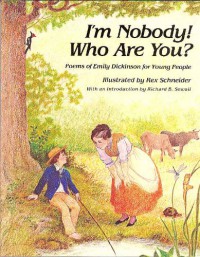Im Nobody Who Are You (Poetry for Young People Series)
 I've been mooning about for the last some months trying to remember the name of this book because my memories of it are so strong & I thought the kids might really dig on some Dickinson. Every time I try to spell the word "reverie" - I'm a crap speller, which I think Dickinson might approve of, although maybe it's more punctuation she liked to mess with - I think of the poem:
I've been mooning about for the last some months trying to remember the name of this book because my memories of it are so strong & I thought the kids might really dig on some Dickinson. Every time I try to spell the word "reverie" - I'm a crap speller, which I think Dickinson might approve of, although maybe it's more punctuation she liked to mess with - I think of the poem:To make a prairie it takes a clover and one bee,
One clover, and a bee.
And revery.
The revery alone will do,
If bees are few.
See! Once I looked up this poem I see why I always want to spell reverie with a y - Emily, my main girl, does this, and this is where I first encountered the word. I feel like I've just learned something important about myself & my bad spelling. Blame it on Emily D.
Anyway, freak out about spelling aside, I just found this book in the house - finally! - and I'm all NOOOOOOOOOOOO. The poems continue to be great, just fantastic, even if the more darkly themed ones are absent - no Death stopping kindly by, no wooden way mechanically going 'round. And this is a pretty large collection, not just the usual 5 pages of poem with 20 pages of art for fill that you sometimes find in kid's poetry collections.
This is why I'm sad: I dislike the art. I loved it as a kid: the cloud children climbing over the purple stile; a wind-blown woman holding her hat as she looks out over the sea; the half-smile of the woman in her solitary prairie. Maybe it's just that I've grown to dislike colored pencil - I'm trying hard to think of an artist who works in that medium that I really love - nope, nothing - but these drawings are, to my adult eyes, amateurish and overly literal. For example, for the poem "Will there really be a morning" the artist renders a thing with feathers with water-lilies for feet, as the poem suggests. Or the riddle-like poem that ends with "And I'm a rose!" illustrated by a rose with a creepy face looking out of it. Eeek! Horror show. The people verge on cartoon while the landscapes are naturalistic, which means that most of the pictures with people are stylistically jarring. (The landscapes are quite good, though.)
The childhood memory is both fragile and durable. Reading this book again has shattered the nostalgic glass I'd set around it, but I found again the deep centering of my love for Dickinson. Her poems are so odd - the lines don't scan, or have to be read in a really artificial way to get the rhythm to work; she denies you a proper rhyme more often than not; she turns your attention to minutia in a way that might be overly precious if it didn't have a...what?... subversiveness?...odd angle? Like this about two robbers finding a "lonely house":
How orderly the kitchen'd look by night,
With just a clock --
But they could gag the tick,
And mice won't bark --
And so the walls don't tell,
None will.
It's just weird - barking mice, the violence to the clock, which is usually understood to have a face, but not a mouth to gag. The old couple wake up in the morning and "fancy the sunrise left the door ajar!" It's like the metaphor is backwards - I can easily imagine a poem about how night steals in like a thief and fills all the corners with menace or something - it almost writes itself - but here real thieves are mistaken for the sun. Not backwards maybe, inside out? Strange regardless.
Anyway, much as I'm disappointed to be sweeping up the shards of my childhood memories, I'm happy to find Emily again, not unchanged, but undiminished.


